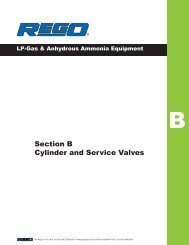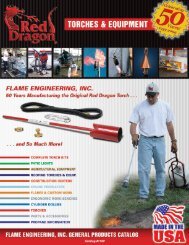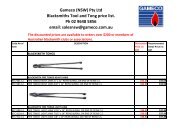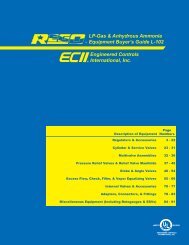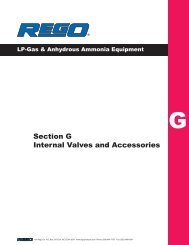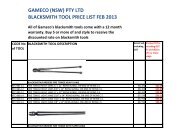Repair Kits Available By Part Number Section 2 Page - GAMECO
Repair Kits Available By Part Number Section 2 Page - GAMECO
Repair Kits Available By Part Number Section 2 Page - GAMECO
You also want an ePaper? Increase the reach of your titles
YUMPU automatically turns print PDFs into web optimized ePapers that Google loves.
PNEUMATIC ACTUATOR INSTALLATION:<br />
NOTE: RegO Lubricant compound #11550-215 or the equivalent should<br />
be applied in a light coating when specified. Torque tolerance is ±10<br />
in/lbs. Refer to Diagram 2 during assembly of the pneumatic actuator.<br />
1. Remove the clevis and clevis locknut from the air chamber shaft.<br />
Remove the cotter pin and pivot pin from the clevis.<br />
2. Assemble the air chamber to the bracket using the air chamber nuts<br />
and lockwashers. Center the air chamber shaft in the clearance hole of<br />
the bracket. Torque to 375 in/lbs.<br />
3. Reassemble the clevis and clevis locknut to the air chamber shaft.<br />
Adjust the clevis so that the center of the pivot pin hole is 2 7 / 8 " from the<br />
bracket with the pivot pin holes in the horizontal plane. Lock the clevis<br />
in place with the clevis locknut using 200 in/lbs. torque.<br />
4. Mount the above bracket assembly to the valve face with the bracket<br />
screws and lockwashers. Be sure that the top of the bracket is flush<br />
and even with the upper edge of the valve face and centered around<br />
the hex of the packing gland. Torque the bracket screws to 250 in/lbs.<br />
5. Assemble the collar washer and then collar onto the valve stem.<br />
6. Lubricate the jam pin and all the openings in the crank arm. Assemble<br />
the jam pin into the crank arm, small end to the top, and align so that<br />
the 5/8" diameter crank arm hole is unobstructed.<br />
7. Assemble crank arm onto the valve stem and rotate it clockwise so that<br />
the crank arm leg clears the clevis legs. Push assembly onto stem until<br />
contact is made with the collar. Rotate the crank arm counterclockwise<br />
so the leg positions itself between the legs of the clevis. Be sure holes<br />
are in alignment.<br />
8. Using the end of a pencil or the equivalent, push down on the jam pin<br />
from the top of the crank arm to engage its flat with the valve stem flat.<br />
The jam pin should drop approximately 3/8". Move or wiggle the crank<br />
arm slightly while pushing down on the jam pin to help assure proper<br />
alignment.<br />
9. Assemble the jam nut fully onto the jam screw. Assemble the jam<br />
screw into the crank arm and torque to 200 in/lbs. Turn and torque<br />
down the jam nut.<br />
10. Assemble the two pivot pin washers onto the pivot pin. Lubricate the<br />
pivot pin shaft and assemble through the holes of the clevis legs and<br />
crank arm leg. The air chamber shaft can be displaced manually along<br />
with movement of the crank arm to effect alignment. Once the pivot<br />
pin is engaged, check the top surface of the crank arm in relationship<br />
to the top edge of the valve face, or to a horizontal, as viewed from<br />
the end of the valve stem. The crank arm top surface should be at a<br />
slight angle to the left, as if rotated counterclockwise from the<br />
horizontal approximately two to three degrees. Measure the clearance<br />
between the roller and end of the poppet. It should measure 3/32" ±<br />
1/64".<br />
Should an adjustment be necessary, follow these procedures:<br />
a) Remove the pivot pin and pivot pin washers.<br />
b) Rotate the crank arm counterclockwise until the leg clears the clevis.<br />
c) Loosen the clevis locknut and adjust the clevis appropriately, in or out.<br />
A half turn of the clevis changes the angle approximately one degree,<br />
or the roller/poppet clearance by 1/64".<br />
d) Reassemble the pivot pin and pivot pin washers. Check again for<br />
proper angle/clearance. Once correct, lock the clevis in place with the<br />
clevis locknut.<br />
11. Assemble the cotter pin into the pivot pin hole. Spread and turn back<br />
the cotter pin legs around the pivot pin shaft.<br />
FUNCTIONAL TESTING:<br />
Connect a 50-60 psig air line through a pressure regulated valve to the<br />
actuator.<br />
Bench Test<br />
Slowly and alternately apply 0 to 35 psig air pressure to the actuator two<br />
or three times while checking for binding and any interference. Make any<br />
necessary adjustments so the actuator operates freely.<br />
Installed Test<br />
Same as the bench test, except a higher air pressure may be necessary<br />
if tank pressure is present.<br />
Diagram 2 – Pneumatic Actuator Installation<br />
RegO A3219F600L<br />
4" Internal Valve<br />
Bracket Lockwashers<br />
Air Chamber<br />
Bracket Screws<br />
Valve Face<br />
Packing Gland<br />
Valve Stem<br />
Air Chamber Nuts<br />
Air Chamber Lockwashers<br />
Collar Washer<br />
Jam Screw<br />
Jam Nut<br />
Jam Pin<br />
Cotter Pin<br />
Clevis<br />
Locknut<br />
Collar<br />
Clevis<br />
Pivot Pin Washers<br />
Crank Arm<br />
Pivot Pin<br />
3



